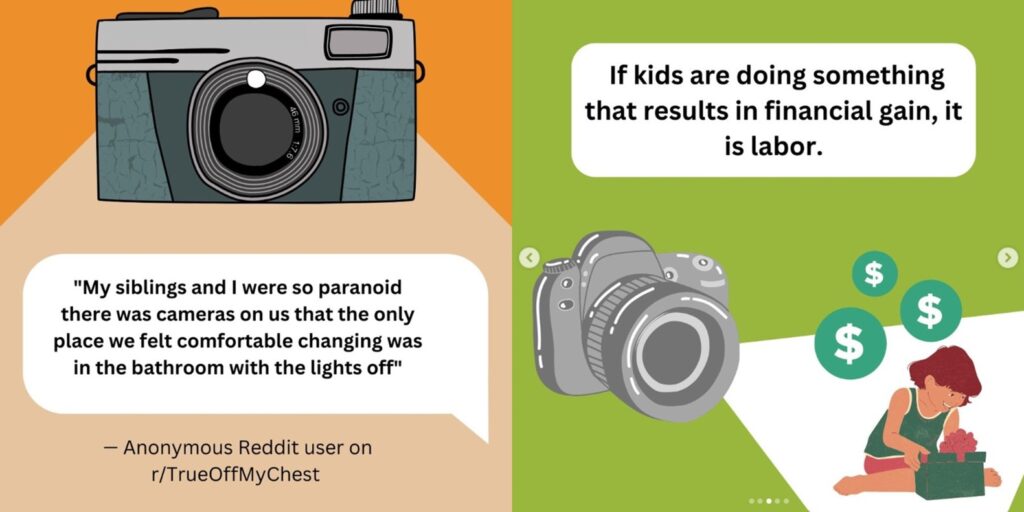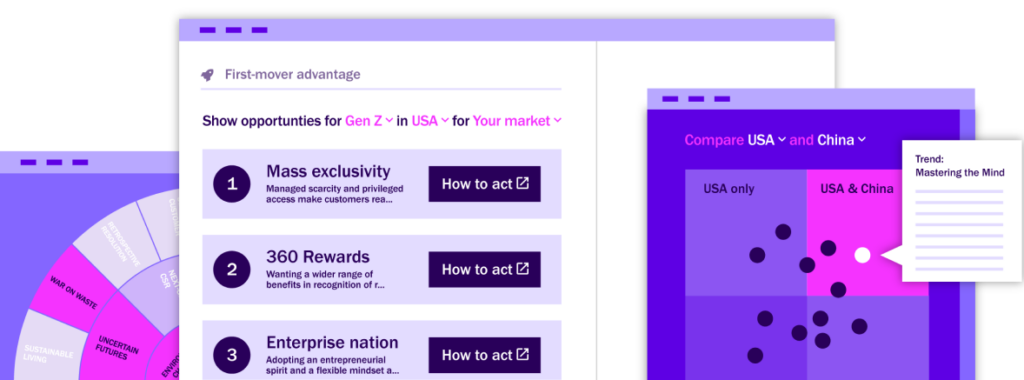Should children get paid if they appear in their parents’ social media content? Why are laundry detergents getting the luxury treatment? And why are young people having to relearn the basics of social interaction?
Below we explore 3 new consumer insights and behaviors that got us talking this summer, with actionable recommendations for brands.
1. Kids don’t want to be “content” for their parents

In a TikTok video shared by user @kodyeelyse, she asks her children – who are out of frame – why she doesn’t post about them on the internet. “Because it’s not safe”, they respond. “You guys are your own people, right? And do people deserve privacy if they want? Do even kids deserve privacy?” “Yeah”, the kids reply. The clip has had over 175,000 likes.
Thanks to social media, it’s not just traditional celebrities who have a platform for elevating their kids. All it takes is a smartphone camera and a social media account to share pictures and videos of all the cute, comical and quirky things children get up to, with the potential for virality with every post. Millennial and Gen Z parents may have good intentions when they share such posts, also known as “sharenting”, but it’s likely to have a dramatic impact on how Gen Alpha approach social media in the future.
Already, some parents and activists are pushing back against a social media culture that largely doesn’t question the privacy implications of posting about children without their consent. An advocacy group called Quit Clicking Kids was created in early 2023 to “combat the monetization of children on social media”.
Young people who grew up being watched online are also increasingly coming to terms with how it has impacted them. 23-year-old TikTok creator Cam, who uses they/them pronouns, has gained a following for speaking out about their situation. Cam’s mother began posting photos and videos of them on MySpace when they were young, and it’s taken a toll on their mental health. “I was able to understand social media more as I got older, and that’s when I got really, really bad paranoia about who’s watching me and who’s looking at me”, Cam told NBC News.

Legislation is beginning to catch up with this sentiment. In France, a proposed bill would prosecute parents for earning money by posting images of their children online. Parents could also have their rights to share images of their kids removed “if the dissemination of the child’s image by both parents seriously affects the child’s dignity or moral integrity”. Bruno Studer, the politician who put the French bill forward, notes that children have on average 1,300 photos of themselves circulating on social media platforms by the time they’re 13 – before they are even allowed to have an account of their own.
Lawmakers in Illinois are looking to introduce a similar bill, which would entitle child influencers under the age of 16 to a percentage of earnings based on how often they appear in online videos, family vlogs and other content.
See beyond
– Gen Z are accustomed to oversharing online – from unreserved “get ready with me” (GRWM) videos and vulnerable confessionals to “live quitting” posts. These are indicators that Gen Z subscribe to our Unapologetically Me trend, choosing to be candid online and express their true selves. But it’s also suggestive of this cohort’s tendency to view their personal Data as Currency.
– While Gen Z may be willing to trade their privacy for likes, Gen Alpha may lean more toward a Going Incognito mindset, striving for privacy and invisibility at any cost. If Gen Alpha become the anti-social media generation, what will this mean for brands trying to reach them on online channels? Will they reject mainstream platforms in favor of smaller, more intimate Niche Networks?
– One possible outcome for Gen Alpha is that they will demand better protections online, both for themselves and for their own children in future. Could your brand have a role to play in creating such guidelines and advocating for new legislation? How can you help to ease generational tensions as children come of age and fight for their right to privacy?
2. Luxury laundry detergents are the latest status symbol

“Fall in love with the scent of your own skin”, reads a product description on Buff City Soap’s website, describing the item as “subtle yet luxurious, combining the sweetness of raspberry and peach with the warm embrace of patchouli and sandalwood”. At first glance, you might assume it’s talking about a candle, perfume or other beauty product. But in reality, it’s describing a category we don’t often think of as high-end: laundry products
“Bougie laundry detergents”, as they’re known in TikTok speak, have garnered the attention of Millennials and Gen Z who are spending upwards of £30 on such products. To put this into context the popularity of laundry-related content, #laundrytok has more than 4.5 billion views, with 56% of viewers falling in the 18-24 age range (source: TikTok).
A string of beauty brands have been quick to carve out a space on the luxury laundry aisle. Dr. Barbara Sturm, whose namesake luxury skincare brand’s bestseller serum is priced at $250, launched the Sturm Home Laundry Detergent in May 2023. It’s sold in a white plastic pouch, includes a silver-branded measuring cup, and is priced at £40 per liter. Similarly, vegan fragrance brand Dedcool and luxury hair-care line Ouai collaborated in May 2023 to launch Dedcool x Ouai Melrose Place Dedtergent, a limited-edition $35 product that promises “long-lasting scent that’s like laying in a bed of roses, literally”.
Usually marketed as sustainable and vegan and wrapped in aesthetically pleasing packaging, these laundry detergents hint at consumers’ desire for status, quality and mindful consumption – even in categories as everyday as clothing care. Brands distinguish their offerings from regular detergents by homing in on the quality of the ingredients used: Sturm Home Laundry Detergent is positioned as an “ecological, plant-based formulation that’s free from preservatives, enzymes, microplastics, dyes, brighteners and other potential irritants and created specifically with the skin in mind”.
Luxe laundry is also meant to appeal to consumers who are bored of traditional supermarket detergents. Dedcool founder Carina Chaz said: “For so long, we’ve had one option: Tide. By introducing new inventions in the laundry space, people can finally experience something more authentic.” Our data confirms that there’s an appetite for this: 21% of global consumers say they buy or use luxury brands in the personal care category, rising to 27% among Millennials (Foresight Factory, 16+, 2023).
See beyond
– The boom in luxury laundry detergents coincides with the #cleantok movement, which has amassed more than 26 billion views on TikTok. Capturing consumers’ obsession and fascination with cleaning, this hashtag signals a wider desire to make the home a sanctuary where consumers can wind down, further explored in our trend The Great Indoors. For more on why consumers are increasingly drawn to “clean” ingredients and minimalist branding, read our trend Pure and Simple.
– More broadly, home care and personal care products are being positioned as essential aspects of wellness. This is particularly apparent in the bathroom, which consumers are transforming into spa-like sanctuaries. Catering to the demand for “Everything Showers”, the “spa-throom” offers a meditative space to consumers and serves as a status symbol to show off on social media. Look to our shift Home as Health Hub for more on the home’s role in boosting mental wellbeing.
– Our What’s trending in June? report explores how consumers are also splurging on exclusive groceries, despite economic and financial strains. Hardships such as inflation have been shown to spur an increase in spend on little luxuries, often called “the lipstick index”. This appears to be holding true for consumers today, be it in their appetite for exclusive groceries or in their fascination with bougie bathroom brands. This desire to elevate daily experiences is also echoed in our trend Everyday Celebration.
3. Seeking social health education

A number of recent signals demonstrate a growing consumer desire to relearn the basics of social interaction post-pandemic.
First, consultancy firms Deloitte and PwC announced young recruits in the UK were receiving additional training on teamwork and communication, finding them weaker on these skills than previous grads. Then, smile lessons began growing in popularity in Japan for those not used to the facial expression any longer after years of mask-wearing. Next, a new wellness activity designed to foster relationships launched: Gathers from Peoplehood in the US entail 60 minutes of guided group talking to promote more meaningful connections.
Consumers already recognize the value of spending time with loved ones and focusing on social interaction.
But not everyone feels they have a solid support network around them, or the skills to form new relationships. This is demonstrated by our data which shows that feeling at risk of loneliness is more pronounced among Gen Z.
See beyond
– Especially post-pandemic, consumers are seeking guidance on how to interact with each other and how best to build genuine connections and relationships. This presents an opportunity for brands to help build consumers’ Social Wellness.
– Summer is often seen as a season for socializing, but this can feel even more isolating for those who don’t have a strong network or group of friends. For those who can afford them, social wellness clubs such as Remedy Place can support with this, as can free IRL meet-ups such as book clubs and fitness classes. Similarly, dating app Bumble is exploring formally spinning off its Bumble BFF feature, designed for making friends rather than finding romantic partners. It’s set to be available this summer.
– As a new influx of consumers enters the job market, employers should consider what support and training they provide for soft skills, with a focus on areas where new hires may need extra help.
Meet Collision, the trends and decision-making platform that can make a real difference to your business

These signals first appeared as part of our What’s trending in July 2023? report, published on Collision. Members get access to these reports at the beginning of every month, so they always have a finger on the pulse of consumers and culture. If you’re interested in learning more about Collision and how the platform can make a difference to your business, get in touch today.